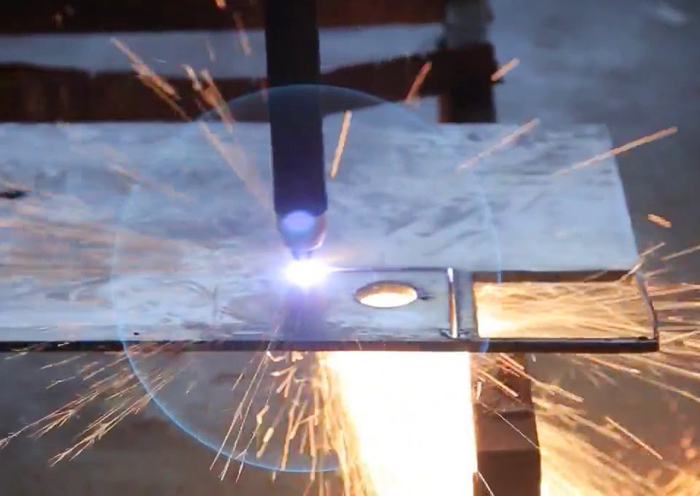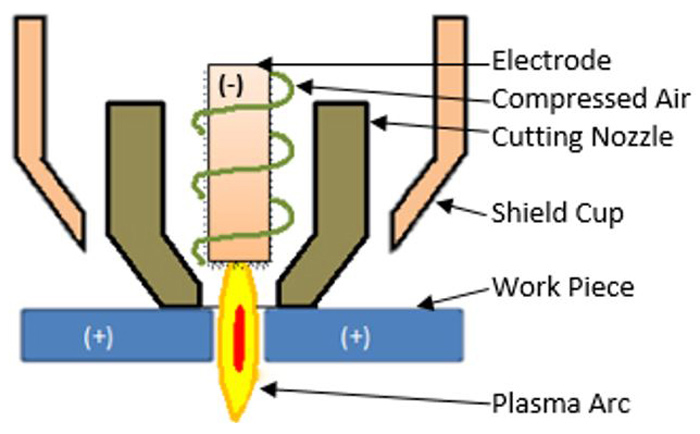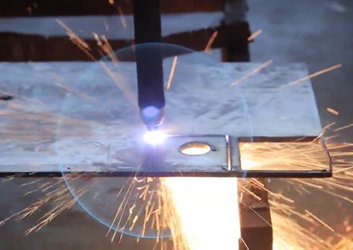Unleashing the power of precision, plasma cutting stands as a stalwart in the world of metal fabrication. Curious about how this incredible process functions, and keen to explore its advantages and disadvantages? Look no further. From its swift and precise cuts to its ability to handle various types of metal, plasma cutting is a vital asset in industrial and artistic sectors alike. Let’s dive into the captivating intricacies of plasma cutting, dissecting its strengths and weaknesses with an unbiased lens.

Photos: youtube.com/@gaochuang3060
The Science Behind Plasma Cutters
Plasma cutting is a process that utilizes an accelerated jet of hot plasma to cut through electrically conductive materials such as steel, aluminum, brass, and copper. The basic principle behind plasma cutting involves creating an electrical channel of ionized gas, i.e., plasma, from the plasma cutter to the workpiece. This ionized gas conducts electricity from the torch of the plasma cutter to the workpiece, resulting in a high-velocity jet of plasma that melts and removes the material, thus creating the cut.
Plasma cutting machines use a combination of gases such as argon, hydrogen, nitrogen, or compressed air to generate the plasma. When the gas passes through a small channel in the cutting nozzle and reaches the electrode, an electrical arc forms, ionizing the gas and turning it into plasma. The temperature of the plasma can reach up to 30,000 degrees Fahrenheit, allowing it to swiftly cut through metals with precision.
Plasma cutting can be performed using handheld torches or mechanized CNC systems. Handheld torches are commonly used for smaller-scale cutting, while CNC systems are employed for intricate and large-scale metal fabrication projects.
Advantages of Plasma Cutting
Plasma cutting offers several advantages, making it a popular choice in metalworking and fabrication industries. One of the primary benefits of plasma cutting is its ability to cut through a wide range of electrically conductive materials, including stainless steel, aluminum, copper, and other alloys. The versatility of plasma cutting makes it a valuable tool for industries involved in manufacturing, construction, automotive, and aerospace.
Another significant advantage of plasma cutting is its speed and precision. Plasma cutters can swiftly slice through metal, delivering clean and accurate cuts with minimal dross or slag. This efficiency not only saves time but also reduces the need for extensive post-cutting cleanup, enhancing overall productivity.
Moreover, plasma cutting is highly portable and can be used in various settings, including workshops, construction sites, and even on-site repairs. Its portability and ease of setup make it a convenient choice for metalworkers who require flexibility in their cutting operations.
Disadvantages of Plasma Cutting
While plasma cutting offers numerous advantages, it also comes with certain limitations. One of the notable drawbacks of plasma cutting is its limited thickness capacity. Compared to other cutting methods such as laser cutting or waterjet cutting, plasma cutting may have restrictions when it comes to cutting thicker materials, particularly in achieving high-quality edge finishes.
Plasma cutting can produce substantial heat-affected zones, especially when working with materials sensitive to high temperatures. This can lead to warping or distortion of the metal, affecting the overall quality of the cut. As a result, careful consideration of material properties and appropriate cutting parameters is essential to mitigate these potential issues.
The initial investment and operational costs associated with plasma cutting equipment may pose a financial challenge for smaller businesses or independent metal fabricators. The need for periodic consumable replacement and maintenance adds to the overall cost of ownership, requiring careful budgeting and planning for long-term sustainability.
Applications of Plasma Cutting
The versatility of plasma cutting lends itself to a wide range of applications across various industries. In the manufacturing sector, plasma cutting is used for fabricating structural components, sheet metal parts, and intricate designs. Its ability to swiftly and precisely cut through metal makes it indispensable in the production of automotive parts, industrial machinery, and agricultural equipment.
In the construction industry, plasma cutting is employed for shaping and cutting metal components used in building structures, bridges, and architectural elements. The speed and accuracy of plasma cutting contribute to efficient construction processes and enable the creation of customized metal components tailored to specific project requirements.
Artistic endeavors also benefit from plasma cutting, as artists and sculptors utilize the technology to create intricate metal artworks, sculptures, and decorative elements. The precision and versatility of plasma cutting allow artists to bring their creative visions to life, adding a touch of metal craftsmanship to various public spaces and galleries.

Photos: askforney.com
Types of Plasma Cutters
Plasma cutting machines are available in various configurations to cater to different cutting needs and production scales. The two primary types of plasma cutters are conventional plasma cutters and CNC plasma cutting systems.
Conventional plasma cutters, also known as handheld or manual plasma cutters, are designed for portable and smaller-scale cutting applications. These units are typically lightweight, easy to handle, and suitable for on-the-go cutting requirements. With a handheld plasma cutter, operators have the flexibility to maneuver the torch for intricate cuts and precise detailing.
On the other hand, CNC plasma cutting systems are equipped with computer numerical control (CNC) technology, allowing for automated and programmable cutting operations. These systems are ideal for large-scale industrial applications, where precision, repeatability, and complex cutting patterns are essential. CNC plasma cutting machines are integrated with advanced software that enables operators to create and execute intricate cutting designs with accuracy and efficiency.
Plasma Cutting Safety Measures
Safety is paramount when working with plasma cutting equipment due to the high temperatures and electrical currents involved in the process. Operators and personnel must adhere to strict safety measures to prevent accidents and ensure a secure working environment.
Proper personal protective equipment (PPE) is essential for individuals operating plasma cutting machines. This includes safety glasses, face shields, flame-resistant clothing, gloves, and appropriate footwear. Additionally, adequate ventilation or fume extraction systems should be in place to remove harmful fumes and gases generated during the cutting process.
It is crucial to inspect and maintain the plasma cutting equipment regularly to ensure that all components, including hoses, torches, and power sources, are in optimal condition. Any signs of wear, damage, or malfunction should be promptly addressed and rectified to prevent potential hazards during operation.
Furthermore, operators should receive comprehensive training on the safe use of plasma cutting machines, including proper handling of the equipment, understanding the specific cutting parameters, and emergency procedures in the event of a malfunction or accident.
Maintenance of Plasma Cutting Equipment
Maintaining plasma cutting equipment is vital to ensure consistent performance, longevity, and operational safety. Routine maintenance tasks for plasma cutting machines include cleaning and inspecting the torch consumables, checking the gas supply for proper pressure and purity, and monitoring the condition of the cutting table or work surface.
The torch consumables, such as electrodes, nozzles, and shields, should be inspected regularly and replaced as needed to maintain optimal cutting quality. Proper cleaning of the torch components and removal of any accumulated spatter or slag help prevent premature wear and maintain efficient plasma arc transfer.
The gas supply system, comprising of the primary cutting gas and secondary shield gas, should be monitored to ensure stable and consistent flow rates. Any fluctuations in gas pressure or impurities in the gas supply can affect the quality of the plasma arc and the overall cutting performance.
Additionally, the cutting table or work surface should be inspected for signs of damage, warping, or excessive wear. Maintaining a flat and clean cutting surface is essential for achieving accurate cuts and prolonging the lifespan of consumable parts.
Choosing the Right Plasma Cutting System
Selecting the appropriate plasma cutting system for specific applications requires careful consideration of various factors, including material types, thicknesses, cutting speeds, and production volumes. When choosing a plasma cutting system, it is essential to assess the following key aspects:
- Cutting Capacity: Evaluate the maximum thickness of materials the plasma cutter can effectively cut, as well as its ability to maintain cut quality across different material types.
- Speed and Precision: Consider the cutting speed, accuracy, and edge quality offered by the plasma cutting system to meet production requirements and quality standards.
- Automation and Integration: Determine the level of automation and integration capabilities required, especially for high-volume production or complex cutting geometries.
- Operating Costs: Assess the overall operational costs, including consumable expenses, maintenance requirements, and energy consumption, to ensure cost-effective long-term operation.
By carefully evaluating these factors and understanding the specific cutting needs of the application, businesses can make informed decisions when investing in a plasma cutting system that aligns with their production goals and quality expectations.
Final Thoughts
Plasma cutting stands as a versatile and efficient method for precision metal cutting, offering a wide array of advantages for industrial, commercial, and artistic applications. While it presents certain limitations and requires diligent safety measures and maintenance, the benefits of speed, versatility, and portability make plasma cutting a valuable asset in the metalworking industry.
Understanding the science behind how plasma cutter works, its advantages, disadvantages, applications, machine types, safety measures, maintenance practices, and the selection process is crucial for harnessing its full potential and ensuring safe and effective operation. With advancements in technology and ongoing innovations in plasma cutting systems, the capabilities and performance of this cutting method continue to evolve, further strengthening its position as a fundamental tool in metal fabrication and processing.
As industries continue to demand precise and efficient metal cutting solutions, plasma cutting remains a cornerstone of innovation and progress, driving the evolution of metalworking processes and contributing to the development of diverse metal-based products and structures. By delving into the captivating intricacies of plasma cutting, we gain a deeper appreciation for its role in shaping the modern landscape of metal fabrication, and the possibilities it unlocks for creativity, productivity, and precision in the world of metalworking.
